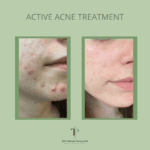
How Can We Remove Skin Tags?
27/07/2025
Acne Treatment Explained | Effective Solutions for Clearer Skin
02/08/2025Most people do not notice the initial signs because the condition begins to develop very gradually while presenting as minor nail discoloration or slight thickening or surface dullness. The minor alteration extends through time to produce brittle nails which develop discoloration and sometimes cause pain. Having a fungal nail infection leads to daily frustration because you feel compelled to conceal your hands and feet at all times. You should know that you share this condition with many others and there exist successful treatments to restore your nails to their healthy appearance. The proper treatment approach enables you to overcome the conditions that made you feel embarrassed or stubborn about your nails. From simple home remedies to advanced medical treatments, today’s options make recovery possible for almost everyone. Restoring your nails is not just about beauty — it is about comfort, confidence, and peace of mind. (Learn more about treatments at Continental Hospitals).
Understanding Nail Fungus
Millions of people worldwide experience nail fungus as a widespread health issue. Dermatophytes represent the fungal group which creates this condition. The fungal organisms gain access to nail bed tissue where they develop into an infection. This article will provide you with information about the causes and symptoms of nail fungus along with its diagnosis and risk factors and preventive measures. (Find more details at Mayo Clinic).
Causes of Nail Fungus
The most common cause is exposure to warm and moist places. This is why it often affects people who wear tight shoes that do not allow the feet to breathe, or those who use unclean nail grooming tools. Nail fungus can also spread in public showers and swimming pools. People with weak immune systems, such as those with diabetes or HIV, are at higher risk.
It is important to know that nail fungus is not caused by poor hygiene. Even people who keep their feet clean and dry can still develop this condition.(Read more at OakDerm).
When to Get Medical Help
See a doctor if you notice any of these signs:
- Discoloration of your nails (white, yellow, brown, green, or black).
- White spots on the nail.
- Thick, brittle, or easily breaking nails.
- Nails that are hard to trim because of texture changes.
- Pain in the affected finger or toe
If you have other conditions such as diabetes, psoriasis, or autoimmune disease, it is especially important to get medical help quickly. If you have already started treatment but don’t see improvement in a few weeks, visit your doctor again, the treatment may not be working. (For more expert advice, visit FCL Skincare).
Fungus Treatment Options
1: Over-the-Counter Remedies
People typically start with OTC antifungal creams combined with ointments or medicated nail polishes to treat mild cases. The active components clotrimazole and undecylenic acid work against the infection. These treatments are cost-effective and simple to locate but require continuous use for multiple months. These treatments deliver optimal results when the fungal infection remains in shallow layers.
2: Prescription Treatments
Doctors will issue more potent medications to patients who do not experience results from OTC products. Terbinafine and itraconazole as oral medications combat fungal infections internally which makes them more effective against resistant cases. Doctors may also prescribe stronger topical medicines to their patients. These effective treatments require medical supervision since they have the potential to harm the liver function.
3: Natural and Home Remedies
People choose to use natural remedies including tea tree oil together with vinegar soaks as well as coconut oil. The available scientific evidence remains limited but numerous individuals experience positive effects from these treatments for minor symptoms. These treatments remain safe for use when combined with guidance from healthcare professionals instead of substituting professional advice.
5: Medical Procedures
Advanced treatment options including laser therapy and nail removal are necessary for severe or resistant infections. The doctor uses laser treatments which employ light energy for fast fungal elimination and may perform nail removal procedures in severe cases. These medical solutions deliver effective results but their higher cost makes them the final option for treatment.
Choosing the Right Treatment for You
The best treatment depends on:
- The intensity of the infection dictates whether OTC remedies will work or if you need prescription medications and procedures for deep infections.
- The cost of OTC treatments stands lower than the expenses of lasers and extended prescription medication usage.
- Some treatments become unsafe for you if you have liver problems or diabetes or other health conditions.
A specialist who focuses on skin and nails will develop a treatment approach which matches your requirements. Your nail appears clear but fungus remains present so you must complete your treatment to stop its recurrence.
Fungal nail infections tend to return after treatment has been completed. To lower the risk, follow these steps. Maintain both cleanliness and dryness of your feet. Public areas such as pools and bathrooms and locker rooms require you to wear shower shoes when visiting them.
How to Prevent Toenail Fungus
Even after treatment, fungal nail infections can return. To lower the risk, follow these steps:
- You need protective footwear or to avoid sharing showers with people who have nail fungus to prevent infections.
- You need to change your socks and shoes every day while choosing footwear that permits air circulation.
- You need to keep your nails clean by using sanitized nail clippers and grooming tools.
- Soak your nails in warm water before nail trimming or trim them right after showering.
- Maintain nail hygiene by using nail clippers and grooming tools which are clean and properly sanitised.
- Before trimming nails you should soak them in warm water or trim them after taking a shower.
- Trim nails short and straight across
- Fungal infections can enter through torn nails so you should avoid pulling off your nails or ripping them.
- Seek medical attention when you suspect the infection has
Conclusion: Maintaining Healthy, Clear Nails
Nail health requires ongoing proper care after treatment to stop reinfection and support normal nail development. Your feet should stay clean and dry while you should wear shoes that allow airflow and apply antifungal products when necessary. A diet rich in vitamins such as biotin and vitamin E promotes healthy nail growth. The circulation system receives better blood flow through regular exercise which provides nourishment to the nails. Dr. Tanja Phillips delivers the newest tools and methods for superior and innovative fungal nail treatment approaches. Through her skilled approach patients receive natural-looking healthy nails that maintain their results permanently


